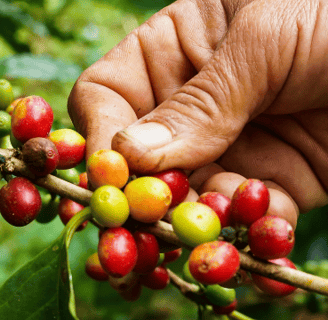From Cherry to Bean: Harvesting Methods at Our Partner Estates
Uncover the power of terroir! We compare the unique growing conditions of our Thailand and Laos coffee farms and how they create remarkably different flavor profiles in your cup.
Ashok Srisenthuran
4/28/20254 min read


From Cherry to Bean: Harvesting Methods at Our Partner Estates
When you sip your morning cup of specialty coffee, each nuanced flavor note begins its journey months earlier during the critical harvest period. At our partner estates in Thailand and Laos, the careful attention to harvesting and processing fundamentally shapes the exceptional coffees we proudly offer. Today, we're taking you behind the scenes to explore how these crucial first steps create the foundation for excellence in your cup.
Harvesting Seasons: A Tale of Two Regions
The natural rhythm of coffee growing varies significantly between our partner estates due to their unique microclimates and elevations.
Thailand's Northern Highlands (Doi Chang Region): Our Thai partner estate experiences a distinct harvesting season that typically runs from November through February. Situated at elevations between 1,200-1,600 meters above sea level, the cooler temperatures at these altitudes slow cherry development, allowing complex flavors to mature fully before harvest begins.
Laos' Bolaven Plateau: Just across the border, our Laotian partner farm operates on a slightly different schedule. Their harvest season begins in October and extends through January, with peak picking activity in November and December. At elevations of 1,000-1,300 meters, the cherries ripen slightly earlier than their Thai counterparts.
The timing of these harvests is carefully monitored by farm managers who evaluate factors like rainfall patterns, temperature fluctuations, and the visual ripeness indicators of the cherries themselves. This deliberate approach ensures that each coffee cherry reaches its optimal sweetness and complexity before being picked.
The Art of Selective Harvesting
Both of our partner farms employ a labor-intensive but quality-focused approach known as selective hand-picking. This method stands in stark contrast to strip harvesting or mechanical collection used in commercial coffee production.
Hand Selection: Precision in Every Pick
At our Thai estate, a team of 40-50 experienced pickers work the slopes during harvest season. Each worker carries a small basket secured at the waist and selectively plucks only the perfectly ripe cherries - those displaying a deep, uniform red color. The unripe cherries remain on the branch to continue developing, and the pickers return to the same trees multiple times throughout the season.
In Laos, the harvest team employs a similar technique, with an emphasis on multi-pass picking. Farm manager Khamphou explains: "We typically make 3-4 passes through each section of the farm. This ensures we're only collecting cherries at their peak ripeness, which directly translates to sweeter, more complex flavor in the cup."
Why Selective Harvesting Matters
The difference between selectively harvested and strip-harvested coffee is dramatic. When only perfectly ripe cherries are selected:
Consistent sugar development ensures proper fermentation during processing
Uniform moisture content leads to even drying
Higher concentrations of desirable flavor compounds create more vibrant cup profiles
Fewer defects require less sorting later in the process
While selective harvesting requires approximately 4-5 times more labor than strip harvesting, the quality difference justifies this investment. The premium prices these specialty coffees command reflect both this labor intensity and the superior cup quality that results.
The Science of Ripeness and Flavor Development
The ripeness of coffee cherries at harvest time is perhaps the single most important determinant of final cup quality. As cherries mature on the branch, profound biochemical changes occur:
Chlorogenic acid levels decrease
Sucrose concentrations increase
Organic acids develop and balance
Aromatic compound precursors form
Our partner farmers carefully monitor their crops for visual indicators of perfect ripeness, which include:
Deep, uniform red coloration (or yellow for certain varieties)
Slight softening of the fruit
Increased glossiness of the skin
Optimal size for the variety
When harvested at this precise moment, the coffee cherries contain the ideal balance of sugars, acids, and aromatic compounds that will ultimately translate to exceptional flavor in your cup.
Stories From the Harvest: Voices From Our Partner Farms
Thailand: Tradition Meets Innovation
At our Thai partner estate, first-generation coffee farmer Sai describes how harvest practices have evolved while maintaining traditional care:
"My previous owner of the plantation taught me to feel the cherry between my fingers before picking - it should yield slightly but not be too soft. This tactile knowledge has been passed down through generations. Today, we've combined this traditional wisdom with modern refractometer measurements to scientifically confirm optimal sugar content at harvest."
The estate has developed a unique incentive system where pickers are paid a premium for higher percentages of perfectly ripe cherries. This has created a culture of quality consciousness throughout the harvest team.
Laos: Community Harvesting Approach
In Laos, our partner estate operates with a community-centered harvesting model. Extended family groups work together on specific farm sections, creating a collaborative atmosphere where quality standards are maintained through social accountability.
"Coffee harvest is a time of community," explains farmer Boun. "Three generations often work side by side. The grandparents have the most experienced eyes for spotting perfect ripeness, while younger workers handle the more physically demanding aspects. This knowledge transfer happens naturally as we work."
Quality Control: Sorting for Excellence
Harvesting is just the beginning of a rigorous quality control process. At both estates, multiple sorting steps ensure only the finest cherries continue to be processed:
Initial Field Sorting: Pickers perform basic sorting as they harvest, separating unripe or defective cherries.
Float Test: Harvested cherries undergo a water flotation test - those that float (indicating lower density or defects) are removed.
Color Sorting: Workers manually separate cherries by color on sorting tables, removing any remaining underripe or overripe fruits.
Size Grading: Cherries are passed through screens to ensure size uniformity, which promotes even processing.
At our Thai partner estate, they've implemented an additional quality control measure - recording harvest data for each micro-lot. This traceability allows them to correlate specific picking dates and conditions with final cup scores, continuously refining their approach.
The Direct Connection to Your Cup
The meticulous attention to harvesting and sorting directly impacts what you taste in your final cup of coffee:
Clean, articulated flavor notes result from harvesting only perfectly ripe cherries
Sweetness and complexity develop fully when cherries reach optimal maturity
Distinctive regional characteristics are preserved through careful handling
Consistency between batches comes from standardized quality control
The next time you detect those distinctive notes of tropical fruit and chocolate in our Thai offering, or the honey-sweet body and spice notes in our Laotian coffee, you're experiencing the direct result of these careful harvesting decisions.
Looking Forward: Next Steps in Processing
After harvesting, the cherries move immediately to processing - the critical next step that will further define the coffee's character. In next week's post, we'll explore how our partner farms process their carefully harvested cherries, comparing washed, natural, and honey processing methods and their impact on flavor development.
At One Estate Coffee, we believe transparency in every step of the coffee journey creates a deeper appreciation for this extraordinary beverage. We're proud to partner with farms that prioritize quality at every stage, beginning with these crucial harvesting practices.
© 2024. One Estate. All rights reserved.


